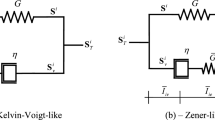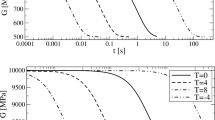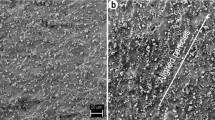Abstract
In this paper, a model of viscoelastic anisotropic deformation is proposed with the different inelastic spin effects considered. The model considering three different inelastic spin assumptions. Numerical simulations show that when the cyclic load is applied, the results corresponding to the model considering different inelastic spins are very different. Thus, when the viscoelastic model is used to simulate actual material, the inelastic spin assumption should be carefully selected.






Similar content being viewed by others
REFERENCES
K. A. Mokhireva and A. L. Svistkov, “A new approach to describe the elastic behavior of filled rubber-like materials under complex uniaxial loading,” Int. J. Solids Struct. 202, 816–821 (2020). https://doi.org/10.1016/j.ijsolstr.2020.07.005
C. Rdbab, B. Dea, B. Rea, et al., “Mechanical properties of the spinal cord and brain: Comparison with clinical-grade biomaterials for tissue engineering and regenerative medicine,” Biomaterials 258, 120303 (2020). https://doi.org/10.1016/j.biomaterials.2020.120303
P. Wang, M. Todai and T. Nakano, “Beta titanium single crystal with bone-like elastic modulus and large crystallographic elastic anisotropy,” J. Alloys Compd. 782, 667–671 (2019). https://doi.org/10.1016/j.jallcom.2018.12.236
J. Gillibert, M. Brieu, and J. Diani, “Anisotropy of direction-based constitutive models for rubber-like materials,” Int. J. Solids Struct. 47, 640–646 (2010). https://doi.org/10.1016/j.ijsolstr.2009.11.002
M. Onoda, T. Okamoto, K. Tada, et al., “Polypyrrole films with anisotropy for artificial muscles and examination of bending behavior,” Jpn. J. Appl. Phys. 38, 1070–1072 (1999). https://doi.org/10.1143/JJAP.38.L1070
G. D’Avino, F. Greco, and P. L. Maffettone, “Particle migration due to viscoelasticity of the suspending liquid and its relevance in microfluidic devices,” Annu. Rev. Fluid Mech. 49, 341–360 (2017). https://doi.org/10.1146/annurev-fluid-010816-060150
C. R. Lee and H. Y. Jeong, “Development of headform impactor finite element model considering the hyperelastic and viscoelastic responses of rubber,” Int. J. Auto. Tech. 19, 523–534 (2018). https://doi.org/10.1007/s12239-018-0050-z
Y. Shi, F. Yang and W. Qian, “Photoacoustic viscoelasticity imaging dedicated to mechanical characterization of biological tissues,” J. Innov. Opt. Heal. Sci. 10, 4 (2017). https://doi.org/10.1142/S1793545817300051
H. Zhang, J. Y. Yu, Z. L. Cao, et al., “Rheological model and viscoelasticity of crumb rubber modified bitumen,” in Materials Science Forum, Vol. 913 (Trans Tech Publications Ltd., 2018), pp. 1076–1082. https://doi.org/10.4028/www.scientific.net/msf.913.1076
J. C. Simo and Hughes, Computational Inelasticity (Springer-Verlag, New York, 2000).
R. M. Christensen, “Theory of viscoelasticity,” J. Appl. Mech. 38, 720–720 (1971). https://doi.org/10.1115/1.3408900
R. A. Schapery, “Nonlinear viscoelastic solids,” Int. J. Solids Struct. 37, 359–366 (2000). https://doi.org/10.1016/S0020-7683(99)00099-2
B. D. Coleman and W. Noll, “Foundations of linear viscoelasticity,” Rev. Mod. Phys. 33, 239–249 (1961). https://doi.org/10.1007/978-3-642-65817-4_6
P. Haupt and J. L. Wegner, Continuum Mechanics and Theory of Materials (Springer, Berlin, Heidelberg, 2002).
R. Keunings, “Theory of viscoelasticity: an Introduction,” J. Non-Newtonian Fluid Mech. 13, 233–235 (1983). https://doi.org/10.1016/0377-0257(83)80020-2
J. C. Simo, “On a fully three-dimensional finite-strain viscoelastic damage model: Formulation and computational aspects,” Comput. Method. Appl. M. 60, 153–173 (1987). https://doi.org/10.1016/0045-7825(87)90107-1
J. C. Simo and M. Ortiz, “A unified approach to finite deformation elastoplastic analysis based on the use of hyperelastic constitutive equations,” Comput. Method. Appl. M. 49, 221–245 (1984). https://doi.org/10.1016/0045-7825(85)90061-1
S. Reese and S. Govindjee, “A theory of finite viscoelasticity and numerical aspects,” Int. J. Solids Struct. 35, 3455–3482 (1998). https://doi.org/10.1016/S0020-7683(97)00217-5
D. W. Holmes and J. G. Loughran, “Numerical aspects associated with the implementation of a finite strain, elasto-viscoelastic–viscoplastic constitutive theory in principal stretches,” Int. J. Numer. Meth. Eng. 83, 3 (2010). https://doi.org/10.1002/nme.2850
D. Peric and W. Dettmer, “A computational model for generalized inelastic materials at finite strains combining elastic, viscoelastic and plastic material behaviour,” Eng. Comput. 20, 768–787 (2013). https://doi.org/10.1108/02644400310488862
J. Lubliner, “A model of rubber viscoelasticity,” Mech. Res. Commun. 12, 93–99 (1985). https://doi.org/10.1016/0093-6413(85)90075-8
T. D. Nguyen, R. E. Jones, and B. L. Boyce, “Modeling the anisotropic finite-deformation viscoelastic behavior of soft fiber-reinforced tissues,” in Proc. of ASME Summer Bioengineering Conference, June 20–24, 2007, Keystone, Colorado, USA (ASME, 2007), pp. 445–446. https://doi.org/10.1115/SBC2007-176919
J. E. Bischoff, E. M. Arruda, and K. Grosh, “A rheological network for the continuum anisotropic and viscoelastic behavior of soft tissue,” Biomech. Model. Mech. 3, 56–65 (2004). https://doi.org/10.1007/s10237-004-0049-4
M. A. Caminero, F. J. Montáns, and K. J. Bathe, “Modeling large strain anisotropic elasto-plasticity with logarithmic strain and stress measures,” Comput. Struct. 89, 826–843 (2011). https://doi.org/10.1016/j.compstruc.2011.02.011
M. Latorre and F. J. Montans, “On the interpretation of the logarithmic strain tensor in an arbitrary system of representation,” Int. J. Solids Struct. 51, 1507–1515 (2014). https://doi.org/10.1016/j.ijsolstr.2013.12.041
M. Latorre and F. J. Montans, “Anisotropic finite strain viscoelasticity based on the Sidoroff multiplicative decomposition and logarithmic strains,” Comput. Mech. 56, 503–531 (2015). https://doi.org/10.1016/j.compstruc.2015.09.001
M. Latorre and F. J. Montans, “Fully anisotropic finite strain viscoelasticity based on a reverse multiplicative decomposition and logarithmic strains,” Comput. Struct. 163, 56–70 (2016). https://doi.org/10.1016/j.compstruc.2015.09.001
C. Sansour and J. Bocko, “On the numerical implications of multiplicative inelasticity with an anisotropic elastic constitutive law,” Int. J. Numer. Methods Eng. 58, 2131–2160 (2003). https://doi.org/10.1002/nme.848
M. Á. Sanz, F. J. Montáns, and M. Latorre, “Computational anisotropic hardening multiplicative elastoplasticity based on the corrector elastic logarithmic strain rate,” Comput. Method Appl. M. 320, 82–121 (2017). https://doi.org/10.1016/j.cma.2017.02.027
M. Latorre and F. J. Montans, “What-You-Prescribe-Is-What-You-Get orthotropic hyperelasticity,” Comput. Mech. 53, 1279–1298 (2014). https://doi.org/10.1007/s00466-013-0971-3
E. H. Lee, “Elasto-plastic deformation at finite strain,” J. Appl. Mech. 36, 1–23 (1969). https://doi.org/10.1115/1.3564580
E. H. Lee and R. M., “Concerning elastic and plastic components of deformation,” Int. J. Solids Struct. 16, 715–721 (1980). https://doi.org/10.1016/0020-7683(80)90013-X
H. Xiao, “Unified explicit basis-free expressions from time rate and conjugated stress of an arbitrary Hill’s strain,” Int. J. Solids Struct. 22, 3327–3340 (1995). https://doi.org/10.1016/0020-7683(94)00307-I
Author information
Authors and Affiliations
Corresponding author
THE FOURTH-ORDER TRANSFORMATION TENSOR
THE FOURTH-ORDER TRANSFORMATION TENSOR
The Hill material strain is represented as follows:
The time derivative of the general material strain is [33]
where \(\boldsymbol\Omega _{{}}^{\text{Lag}}\) is Lagrangian spin. Considering \(f\left( \lambda \right) = \ln \lambda \), then the time derivative of the logarithmic strain is
Notably, there is a limit
The time derivative of the logarithmic strain can also be expressed as follows:
where \({\boldsymbol{a}_{i}} = {\boldsymbol{n}_{i}} \otimes {\boldsymbol{n}_{i}}\), the above-mentioned expression can be represented as follows:
where the transformation tensor is
Eq. (A-41) can also be expressed as follows:
where
Thereby
About this article
Cite this article
Meng, C., Chen, M. An anisotropic finite strain viscoelastic model considering different spin effects on the intermediate configuration. Mech. Solids 57, 382–395 (2022). https://doi.org/10.3103/S002565442202008X
Received:
Revised:
Accepted:
Published:
Issue Date:
DOI: https://doi.org/10.3103/S002565442202008X




